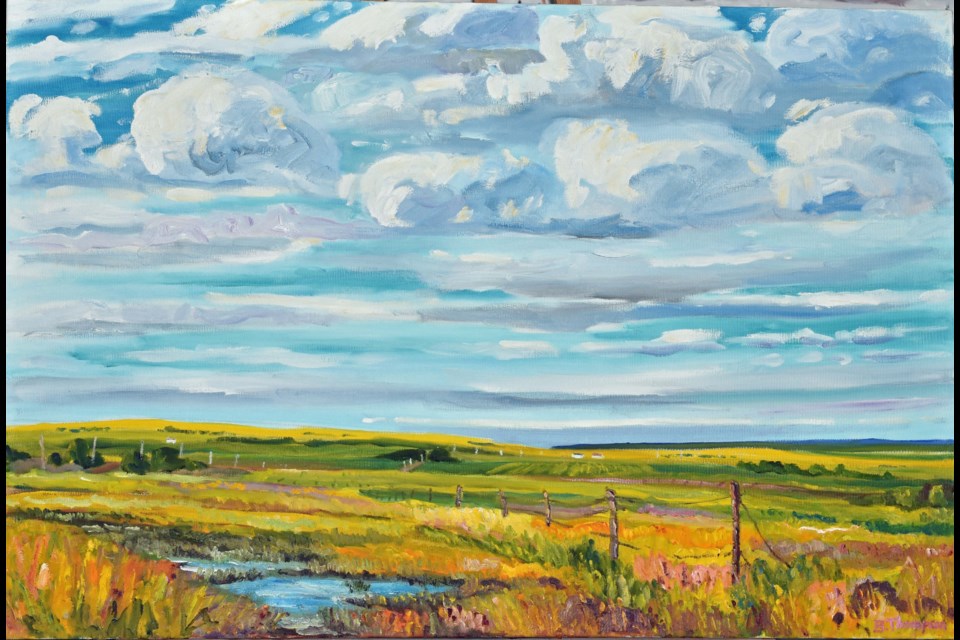What is good art? That’s a question every art collector asks at one time or another. For visual artist Bruce Thompson, the answer is based on personal preference.
“It’s something you can hang in your living room, and every morning when you have your cup of coffee, you see something different," Thompson said. "It may not be logical, but the possibilities are there.”
As Dr. Bruce Thompson, an environmental scientist, the St. Albert resident has worked throughout Canada, in addition to about 30 countries in Africa, Asia and the Americas. He has helped eliminate deadly parasites in Africa, developed regulations for hazardous waste in Mexico, and conducted an environmental assessment for a proposed thermal coal electricity generation plant in Henan province, China.
His scientific career has been packed with “possibilities.” He applies the same alluring logic to art. Thompson, whose earliest watercolour and oil paintings date back to 1985, is currently experimenting with digital art – another avenue for possibilities.
Up until 2016, Thompson’s visual art was focused on painting sensitive ecological areas such as grasslands, lakeshores, wetlands, fields and mountains. A great deal of his work as a scientist had been with Indigenous communities assessing how plants, soil, water and air function together as an ecosystem. The scientist’s discoveries naturally seep into the visual artist’s oil-based landscapes.
Since painting his initial canvases, Thompson gradually progressed from small realistic watercolour canvases to large more colourful oils. But every visual artist reaches a point when their creative juices demand fresh challenges, and Thompson was moving in the direction of abstract digital art.
In creating digital art, he does more than click a mouse and draw on a computer screen. Each piece of digital art is based on one of Thompson’s original paintings. He first takes a photograph of the painting and inputs it into programs such as Adobe, Corel or Pixel Bender.
“I found the tools to manipulate the pixels. When you run the tools across an image, there’s a huge explosion of colour. The tools – I call them digital brushes – rearrange the pixels. You can wave them across the pixels and rearrange the amplitude and strength. You can move the brush any way you want.”
The digital brushes permit changes into the abstract. They can change the colour. For example, programs can take the wavelength of a green hill and with the click of a number change it to yellow, purple or any imaginable colour. The program also allows an artist to change shapes, wavelength and the configuration of pixels according to a programmed algorithm.
During the first attempts, Thompson’s images were just pictures on a screen until he met Klyment Tan, an Edmonton-based artist, photographer and imaging consultant. Klyment assisted Thompson in the process’s next step – moving the freshly created digital images to a canvas.
Klyment had the high-tech knowledge of colour and materials for projecting a digital image onto a solid surface – anything varying from canvas, paper, metal or any other material with a coating that allows pigments to adhere.
“He’s a genius on digital colour surfaces. He’s developed a way of producing them on canvas,” said Thomspon. “He has a printer, a fancy inkjet printer the size of a grand piano. He can print images that are 48 inches wide and infinitely long.”
Although trained as a scientist, Thompson took up painting as a way of viewing the world from a different perspective.
“I just wanted to express how I feel about sights I see on my way to a job. I’ve painted some sights a couple of different times, but they’re different every time. You want to express your feelings about a site you’re attached to.”
During an exhibition of his paintings in 2010, a viewer described one of his pieces as “just a muskeg.” Thompson was a bit annoyed.
“I’d say no. It’s a wetland. We’ve already lost two-thirds of our wetlands since the Europeans arrived. I heard a quote that muskegs are the lungs of Mother Earth. I would add its kidney and liver because it detoxifies organisms and bacteria. They are Mother Nature’s sponge. They regulated the flow of groundwater.”
As a member of Big Lake Artists’ Studio, Thompson’s last showcased his digital art during the July 6 ArtWalk.
“The thing I find most interesting is it’s often the kids who see things in the imagery that I haven’t seen.”
We stoop to look at one of his prairie landscapes turned digital. Sure enough, we spy hidden abstract images that could pass for a hawk, a rabbit or a snake.
“I have 50 per cent control," Thompson said. I can use different digital brushes to produce different effects that hopefully inspires something in the viewer.”
As a scientist, Thompson has spent his life investigating flows – the flow of water, the flow of insects’ lifecycles, the flow of pollution and the flow of different cultures. It’s not a stretch to see him exploring the digital flow of form and colour.




